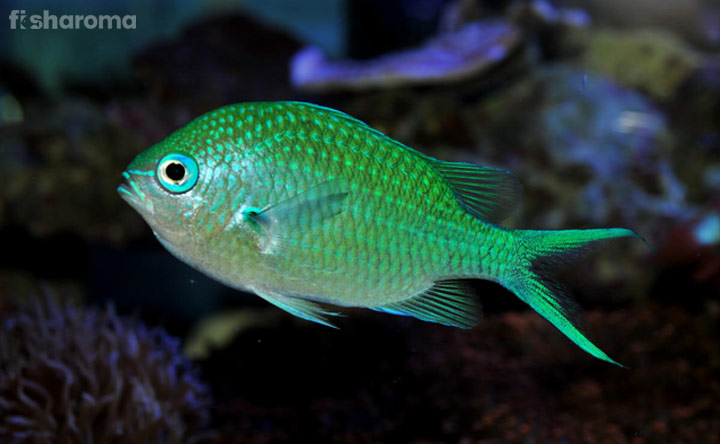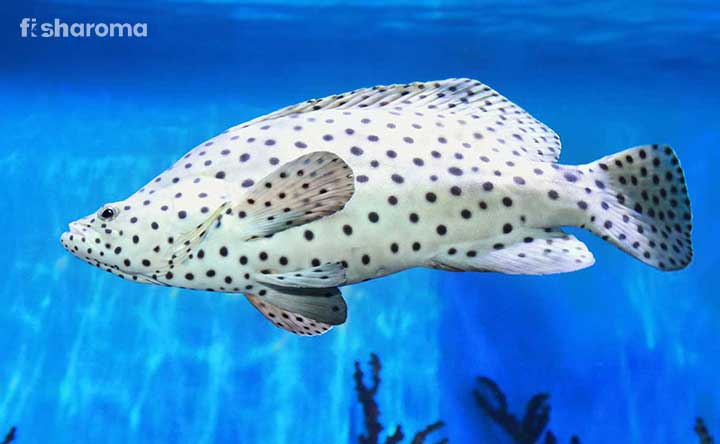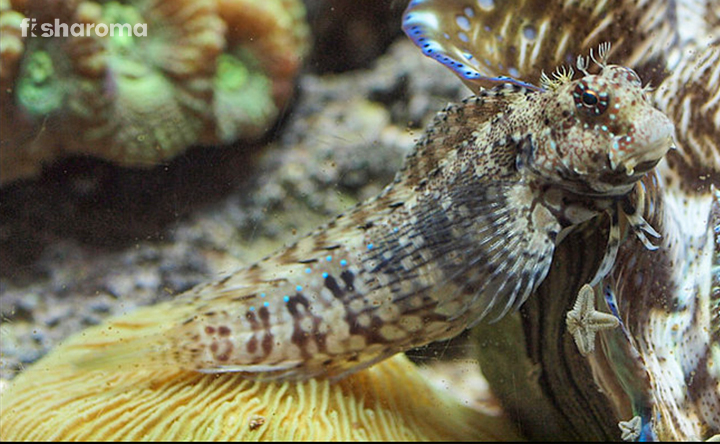Bicolor Blenny: A Care Guide to your Two-Coloured Critter

- Origin & Habitat of Bicolor Blenny
- Appearance of Bicolor Blenny
- Behaviour of Bicolor Blenny
- Lifespan of Bicolor Blenny
- Diet of Bicolor Blenny
- Tank Requirements for Bicolor Blenny
- Water Types for Bicolor Blenny
- Compatibility of Bicolor Blenny
- Breeding of Bicolor Blenny
- Diseases and Treatment of Bicolor Blenny
- Summary
A Bicolor Blenny can take all your time as you keep on watching the hopping around, displaying their bright hue. Yes ! with an amazing combined colouration, this species is sure to enhance the effulgence of your room.
An aquarium is not meant to be only freshwater. Saltwater aquariums with differently-coloured marine species are also an attraction to many aquarists. With brightly-hued saltwater fishes, you might get confused regarding which one is easy to be kept or which one displays its colour at best. However, keeping aside their colour and beauty, you can simply rely on their personality, while choosing one for your marine tank. A Bicolor Blenny comes with such a persona, that you will not think twice before keeping them in a home tank.
With all freshwater species available mostly, many aquarists might get smitten with the fact, how to take care of a saltwater species. Don’t worry, when we are at your fingertips. Go through our care guide and get to know about their diet, water requirements, tank parameters and a little more.
Key Specifications of Bicolor Blenny
Bicolor Blenny is very inquisitive and possesses a strong behavioural generosity, with which they make themselves the best pick for saltwater aquariums. Let us delve into the smaller, yet important quick details of them.
| Scientific Name | Ecsenius Bicolor |
| Origin | Indo-Pacific regions, Maldives and Great Barrier Reefs, Ryuku Islands |
| Lifespan | 2-4 years or a bit longer |
| Colours | Two-coloured; divided into half blue and half orange |
| Temperament | Peaceful except to own species |
| Size | 4.3 inches |
| Diet | Omnivorous |
| Family | Combtooth Blenny or Bleniidae |
| Compatibility | Any other species |
| Tank Size | 30 Gallons |
| Care Level | Easy |
Overview
This Two-colour Blenny is a reef safe species that provides you with immense fun and a fantastic experience. These fishes are very swift, yet peaceful species that prefer to dwell on the bottom part of your reef marine tank. With an endearing identity, they keep on doing entertaining activities that will surely get your attention.
These low-maintained fishes are hardy in nature and they are not trouble makers. They will comfortably stay in a beginner’s tank and will reward you with a dual splash of colour at the cost of one!
Origin and Habitat of Bicolor Blenny
Native to Indo-Pacific regions, these Bicolor species are also available in places like the Maldives, Ryukyu Islands, Fiji, Phoenix Island and Great Barrier Reef. These Blennies prefer to dwell in the shallow waters of the ocean and also like to live in reefs of the marine system.
The natural habitat of these species mainly consists of live rocks, reefs and crevices. The fishes like to swim in the narrow areas within rocks and corals that help them to get confined and make them feel safe. They prefer normal water with an inclination towards warmth. In the wild, they like to live among rocks that are porous and are mature enough to develop algae on them. Follow this regime for your aquarium also, where natural caves and live rocks will provide them with hideouts and places to explore.
Appearance of Bicolor Blenny
This two-coloured fish is slender in shape and has a long body. These Blennies have a dorsal fin that is quite long and makes them somehow look like a sperm whale’s head. They have two beautiful protruding eyes that also hold two antennas. Their colour changes during their breeding time.
The males and females are sexually dimorphic according to their fins’ length. The dorsal fins of the male fishes are significant and larger. The males are also larger in size and are brighter than females. Moreover, they are slimmer and all these features help one to identify which one is male or female.
During breeding, the males change their colour and possess a predominant blue undertone. The males have an egg-like shape in their anal fin, whereas the females own a papilla in their genitals. The fishes have more than one dimorphism feature, which further includes a thick lip for male fishes.
Colour
The colour of this astonishing species is very attractive, where they have a contrast of two vibrant hues. The front portion of these fishes has a blue colour with a pale brown undertone. The rear side is symbolically orange to yellow. With an Eel-like appearance, these cuties are free-swimming creatures that stand out in a reef tank.
During breeding (as we have mentioned earlier in appearance), the males undergo colour change. The front section gradually gets hold of an electrically vibrant blue and makes an appeal to the females.
Size
The size of these hardy fishes generally ranges from 4-4.3 inches.
Behaviour of Bicolor Blenny
Bicolor Blennies are peaceful in nature until they meet one of the same species. They become somehow a little irritated and try to scrap the other Blennies. They are a little bit territorial as they prefer to pop out of caves and if they find their hideouts are being occupied, they become stressed. The fishes are explorers and do not engage in active swimming.
These Blennies are very comfortable when given the bottom of a whole tank. They are not picky towards reefs and hence, you can keep coral reefs in their tank. They are preferably algae eaters and will not destroy your reef decorations. However, when using corals, keep fleshy corals, as these fishes might act out on these if they are underfed. They cannot live in a Nano tank and when in larger tanks, they generally don’t pick at the polyp of corals. So, make an adjustment in selecting their living space as this reflects on their behaviour.
They will not behave normally in case they are kept in different water than their source. It is advisable that you perform a drip acclimation for one hour, at a rate of two drips every second, before you put your Bicolor Blenny in a reef tank.
Lifespan of Bicolor Blenny
A Bicolor Blenny fish can live up to 2-4 years in the wild or in aquarium conditions. However, with proper diet, environment and care they can go beyond their normal life expectancy and live for 10 years in captivity.
Diet of Bicolor Blenny
The diet of a Bicolor Blenny would comprise of an omnivorous menu, where they mostly feed on herbs and plants and sometimes also plunge on meaty proteins. Generally, they prefer a strictly herbivorous diet where they would thrive entirely on algae, pellets and flakes. This is why you are recommended to keep them in a tank full of matured rocks, that can help the growth of algae. Fresh rocks are not suitable for them. Their varied diet includes
- Dead plants
- Algae-based meals (blue-green algae or marine algae)
- Macro-algae (as supplements)
- Macro feast
- Dry Seaweed (twice a week)
Apart from the plant matters, your Blennies will also need an alternative carnivorous diet where they satisfy their need for meat-based proteins. They will prefer to have varied foods that include shrimps (Mysis and Brine) and Krill.
Continuous live algae might turn out to be detrimental to their health and can cause untimely death. So, it is always advisable to provide them with a combined diet of green foods including algae-based to freeze-dried or frozen herbivorous food.
These fishes can best absorb their vitamins when they are soaked in vitamins, which gives them brighter and healthier skin. In order to develop their immunity, you can use a garlic solution. This solution helps to repel parasites, help to prevent Ich and increases immunity as a whole.
In case, these Blennies face any issue in feeding, they become stressed. To avoid this, you can lower the algae by using a PVC Pipe or rubber band. Thus, the algae would get connected to lower level rocks and the fishes can reach their food.
Tank Requirements for Bicolor Blenny
Tank parameters are of pivotal importance as these fishes need completely different factors to dwell within the tank. Their tank must resemble a proper saltwater system. There are a few features that need sharp attention.
Tank Size
The tank size for the Bicolor Blenny must be 30 gallons as they prefer to remain stressless in a free-living area. They prefer to venture out in their residence, without hitting the tank set up or walls. However, this is for one Bicolor and if you plan to double the number by keeping a female and a male (for easy reproduction), then you must increase the tank size.
Tank Lid
These fishes generally don’t come up to the surface, but it is always better to keep a lid tightly on the tank. They just love to hop around and jump from one rock to another. For instance, if a rock’s hole is on the upper portion of the water, there stands a risk of your Blenny jumping out.
Substrates
You can keep sand on the bottom. They also like different decors as they have in their wild marine systems and prefer to play within those places. They don’t have any preference for substrate as such. However, they are very active diggers, hence try to fix all the substrates properly.
Filter
Filtration is very important for any fish, including your Two-coloured Blenny. If they feel any rise of ammonia or minerals and less oxygen they will die. Proper filters must be installed that keep the water movement normal like their natural dwelling place.
Ornaments
Reef safe Blennies show their true self when they get a lookalike environment of their natural habitat. You must keep corals, reefs, rocks and crevices in your Blenny tank. There must be enough holes in the rocks and all the rocks should have hiding spots. Make sure all the rocks and caves are attached well to the tank so that when your fish explores and searches for food, no rock gets toppled on them.
Presence of Flora
The plantation is not that important to Blennies for living. However, keeping plants inside serves best, as they feed on plant matter. The natural supply of their diet is helpful for them and moreover, plants add decoration to your tank. Anchor all the plants tightly so that when the fishes rubble the sand and substrate, the plants do not get loosened.
Lighting
These fishes eat algae, for which there must be abundant growth of algae within the aquarium. In order to help algae grow, provide sufficient lighting to the tank. You can keep the tank beside any light source. For decoration of your tank, you can use normal aquarium lights.
Cleaning Method
Cleaning is very important, as these fishes cannot live if the water gets polluted. The oxygen supply deteriorates and they succumb to death gradually. To save your pet from such disgrace, you must change the water regularly. Changing 10% of the water on a frequent basis is mandatory. Once your tank faces a rise in nitrate level than its usual range of 10 ppm, immediately change the water.
While cleaning the tank and ornaments, do not wipe away all the algae from the rocks. Without a preferable quantity of algae in your diet, your Bicolor might even die. You can clean the sidewalls of the tank by using a soft cloth.
Water Types for Bicolor Blenny
Water parameters are a mainstream feature for keeping your fish healthy and jovial. We advocate you follow the necessary requirements so that you don’t miss out on anything while caring for your cute alien.
Temperature
Though saltwater fish, still Bicolor Blenny prefers the temperature of water to be on the warmer side, ranging from 21-28 Degrees Celsius.
pH Level
The alkalinity of water is their favourite. Keep the pH level from 8.1-8.4.
Hardness
The fish needs a carbonate hardness of 8-12 dKH. It is better to run the level at 7.8 if there is carbon dosing.
Minerals
There must be the presence of calcium with a level of 430 ppm for helping stabilize pH level and nitrate. The phosphate level for the water must be less than 10 ppm and keep the magnesium at a level of 1300 ppm. Keep the aquarium free of ammonia.
Gravity
These fishes need a gravity of 1.020-1.025.
Compatibility of Bicolor Blenny
Two-colour Blenny is a calm and yet very inquisitive being, that can easily attract any fishkeeper. However, if you want to adorn your tank with various colourful species, then you must know which species can be best compatible with your Blenny.
These Blennies never disturb anyone and smoothly swim within small hollows of rocks. Though they are not aggressive, still they do not encourage the presence of any other algae eaters in the same dwelling space.
Suitable Tank Mates
These harmonious fishes can very well share their tanks with other species. They include
- Clownfish
- Dwarf Angelfish
- Damselfish
- Boxfish
- Chromis
- Butterflyfish
Unsuitable Tank Mates
Completely avoid any other algae eater as they don’t actually tolerate anyone eating away their natural food. Moreover, you need to avoid keeping other larger predatory fishes that can eat them away or any other Bicolor Blennies. It is always better to avoid Gobies, Darts and also Seahorses. The Blennies are fast movers and have the same diet as Seahorses. Eventually, being slow-movers, they end up starving as your little Blenny would eat up everything.
It is always advisable to not keep Royal Grammas and Bicolor Pseudochromis with them. The same vibrant colouration and size might create issues for your Blennies, that would end up in the fighting.
Breeding of Bicolor Blenny
These species are mainly grown in the aquarium breeding systems. Although they are easy caring fishes, still, laying eggs during breeding could be a challenging part that is to be navigated. These fishes are nesters along with being egg guarders.
For breeding purposes, you cannot keep one female and one male at the same. As they have a natural characteristic of fighting with their own species, they will do that at first but eventually, they will calm down and mate. The surprising fact is that both the fighting and courting ritual is the same.
While mating, the male fish will change colour (as we have stated above in the colour section) and the pair will hide away in the rocks. Once mating is completed, the female lays the eggs in the corners of rocks and guards their nest. In the wild, they follow the same process though they get less chance to protect their eggs. However, in aquariums, there are many rocks in one place and they get ample space to guard their nest.
Once the eggs hatch, other fishes are at their best to get a chance to have the fries as a snack. This is why you must keep the babies in a separate tank. For feeding them you can give them rotifers, a proper sized food.
Diseases and Treatment of Bicolor Blenny
If not properly acclimated the fish can show signs of stress. They might get saltwater diseases and that can happen owing to water change, transportation or even low quality of water. They can get Ich, where they develop white spots on the body; a further impact of stress.
For proper treatment, you need to quarantine the affected fish and not just drop medicine in the water tank. Other fishes might get infected from the medicine’s side effects.
Summary
Bicolor Blenny is really an aesthetic addition to your tank. Though not demanding, still their care is challenging somehow as they are very sensitive and delicate. Their take care procedure requires the knowledge of an aquarist.
To conclude, Bicolor Blenny fills up your aquarium with a beautiful hue and super adorable activities. Keep these fishes and see them growing in your tank, producing further beautiful offspring. Invest in one, trust us your investment will be worth it!
Care Guides of Similar Pets
If you have found our article to be interesting, you can look for other similar care guides on our website. Check, if these satisfy your need for knowledge.
- Dwarf Lionfish Care Guide: These exotic fishes are marine species and stand to be intimidating to fish keepers. It is advisable that you go through our blog and enhance your interest.
- Spotted Garden Eel Care Guide: A fish or a snake popping out its head from the sand. Know these fishes from the Congridae family.
- Yellow Tang Care Guide: If you are fond of some bright vibrancy in your tank, you can go for these lively Yellow beauties to keep in your tank.









